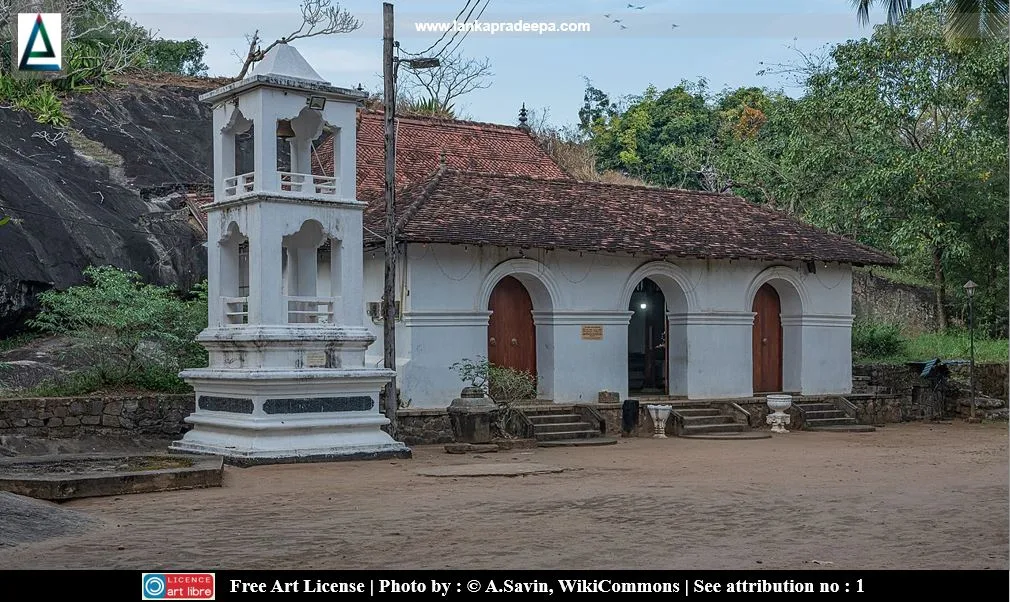
Degaldoruwa Raja Maha Viharaya (also known as Degaldoruwa cave temple) is a Buddhist temple situated in Amunugama in Sirimalwatta, Kandy District, Sri Lanka.
History
This temple is said to be established in 1748 as a tribute for Morathota Rajaguru Maha Nayaka Thera, the teacher of King Kirti Sri Rajasingha (1747-1782 A.D.) when he was a child (Rajapakse, 2016). However, the construction work of the temple was completed by the king's brother Rajadhi Rajasinha [(reigned 1781–1798 A.D.) Rajapakse, 2016]. It is said that King Kirti Sri Rajasingha while constructing the Galmaduwa Viharaya had been living in the Degaldoruwa cave and had devoted his attention to improve it (Abeywardana, 2004).
According to the details in Degaldoruwa Sannasa (a royal grant by King Rajadhi Rajasinha that gives in detail the work done to set up the Degaldoruwa temple), the placing of the eyes in the temple's statues was done in the Saka era 1683 (1761 A.D.) and Rajadhi Rajasinha was instrumental in this construction (Abeywardana, 2004).
The Hewisi Mandapaya (the drumming hall) of Degaldoruwa Viharaya is said to be a later addition by Meegastenne Adhikaram (Abeywardana, 2004).
Image house
The image house of Degaldoruwa temple is famous among the people for its well-preserved Kandyan Era paintings. It belongs to the reign of King Kirti Sri Rajasingha and has been built by enlarging a small cave located on the western slope of the Degaldoruwa rock (Abeywardana, 2004; De Silva & Chandrasekara, 2009). Four artists known as Nilagama Sittara painters were responsible for the paintings at Degaldoruwa (Seneviratna, 1983). They included Nilagama Patabendi (the chief artist), Devaragampola Silvattena (an unordained monk who also worked at Ridi Viharaya), Koswatte Hittaranaide and another unknown artist (Seneviratna, 1983).
The image house consists of three sections, viz; Athul-kutiya (the inner chamber), Meda-kutiya (the middle chamber) and Palamu-kutiya [(the front chamber) De Silva & Chandrasekara, 2009].
The Palamu-kutiya is the first section of the image house. The Meda-kutiya which can be entered through a carved wooden Makara Thorana (the Dragon Arch) preserves a collection of wall paintings belonging to the Kandyan period. The paintings depict the scenes from the Jātaka tales (stories that tell about the previous 550 lives of the Buddha) such as Vessantara, Maha Suthasoma, Sattubhatta and, Maha seelava (Abeywardana, 2004). The roof of the Meda-kutiya is held by carved stone pillars.
An arched shaped entrance with a unique Sandakada Pahana (a moonstone) provides access to the Athul-kutiya. Seven statues of Buddha in seated (2 statues), standing (4 statues), and reclining postures are found inside this shrine (De Silva & Chandrasekara, 2009). The walls as well as the ceiling of the rock cave have been adorned with murals depicting the scenes from the life of the Buddha, other Buddhist themes, and various decorative motifs. The Sath-sathiya (first seven weeks after the enlightenment), Solosmasthana (16 sacred Buddhist sites), Suvisivivarana (24 assurances predicting Buddha-hood) and, Mara Parajaya (conquest of Mara) are some of the paintings found here (De Silva & Chandrasekara, 2009).
A protected site
The ancient image house, paintings, Pohaya Geya, Sangawasa (dwelling house) and the wall surrounding the Bodhi-tree belonging to the Amunugama Degaldoruwa Raja Maha Vihara premises in the Sirimalwatta, Pallegama, No. 633, Grama Niladhari Division in the Kundasale Divisional Secretary’s Division are archaeological protected monuments, declared by the government Gazette notifications published on 22 May 1964 and 24 July 2009.
 .
.
Attribution
1) SL Kandy asv2020-01 img49 Degaldoruwa Temple by A.Savin is under the Free Art License 1.32) SL Kandy asv2020-01 img48 Degaldoruwa Temple by A.Savin is under the Free Art License 1.3
3) SL Kandy asv2020-01 img46 Degaldoruwa Temple by A.Savin is under the Free Art License 1.3
References
1) Abeywardana, H.A.P., 2004. Heritage of Kandurata: Major natural, cultural and historic sites. Colombo: The Central Bank of Sri Lanka. pp.108-109.
2) De Silva, N.; Chandrasekara, D.P., 2009. Heritage Buildings of Sri Lanka. Colombo: The National Trust Sri Lanka, ISBN: 978-955-0093-01-4. p.53.
3) Rajapakse, S., 2016. Pauranika Sthana Ha Smaraka: Mahanuwara Distrikkaya (In Sinhala). Archaeological Department of Sri Lanka. ISBN:955-9159-34-8. pp.99-100.
4) Seneviratna, A., 1983. Golden Rock Temple of Dambulla; Caves of infinite Buddhas. UNESCO-Sri Lanka Cultural Triangle Project. Central Cultural Fund. Ministry of Cultural Affairs, Sri Lanka. pp.79-80.
2) De Silva, N.; Chandrasekara, D.P., 2009. Heritage Buildings of Sri Lanka. Colombo: The National Trust Sri Lanka, ISBN: 978-955-0093-01-4. p.53.
3) Rajapakse, S., 2016. Pauranika Sthana Ha Smaraka: Mahanuwara Distrikkaya (In Sinhala). Archaeological Department of Sri Lanka. ISBN:955-9159-34-8. pp.99-100.
4) Seneviratna, A., 1983. Golden Rock Temple of Dambulla; Caves of infinite Buddhas. UNESCO-Sri Lanka Cultural Triangle Project. Central Cultural Fund. Ministry of Cultural Affairs, Sri Lanka. pp.79-80.
5) The Gazette of the Democratic Socialist Republic of Sri Lanka. No: 1612. 24 July 2009. p.1021.
6) The government notification. No: 14040. 22 May 1964.
Location Map
This page was last updated on 26 April 2022
For a complete tourist map follow this link: Lankapradeepa Tourist Map
For a complete tourist map follow this link: Lankapradeepa Tourist Map


